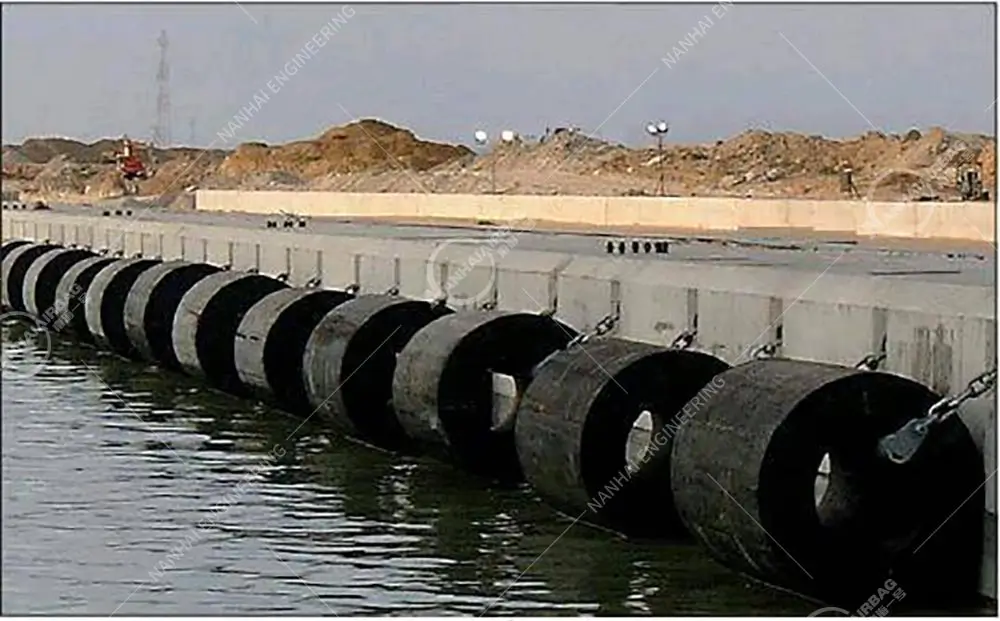Arrangement and selection of pneumatic rubber fenders
06/10/2025How to Hang Pneumatic Fenders on Docks and Ships
06/11/2025Overview of Rubber Fender Technology Development
What Are Rubber Fenders and Why Do They Matter?
Rubber fender, also known as marine fenders or ship fenders, are essential components in modern port and dock systems. Their role is simple yet critical: to absorb the kinetic energy of a vessel during berthing and prevent damage to both the ship and the structure. Without them, the risks of collision damage and structural failure increase dramatically.

Why Talk About Rubber Fender Technology Now?
Global maritime trade is booming, and vessels are getting larger. With more supertankers, cruise liners, and mega-container ships in operation, port infrastructure must evolve rapidly. At our facility, we recently helped upgrade fender systems in an aging port where older D-type fenders couldn’t handle the increased load. The transition to high-energy absorption marine rubber fenders made a noticeable difference in safety and longevity. This illustrates why understanding fender technology is more necessary than ever.
The History of Rubber Fender Development
Rubber fenders have evolved from simple bumpers into high-tech marine safety devices.
The journey began in 1852 in the United States, where the first rubber fender was used. In China, the story started in 1952, and over the past 60 years, the industry has grown dramatically. A significant milestone came in 2001 with the establishment of the Rubber Fender Committee under the China Rubber Industry Association. By 2010, China had become the world’s largest producer of marine rubber fenders, earning it the reputation:
“When it comes to rubber fenders, the world looks to China.“
This rise was powered by strategic shifts. Since the 1990s, the global tire industry has begun shifting eastward. Leading tire giants set up operations in China, increasing localized demand for marine rubber fenders. Instead of relying on imports, these companies sought domestic solutions, sparking innovation in design, process, and equipment.
Types of Marine Rubber Fenders Through the Years
As ships grew bigger, fender designs became more advanced and specialized.
- Cylindrical and D-type fenders were the earliest models, suitable for smaller vessels.
- Later, more advanced options like arch, cone, and cell fenders became the standard for larger port terminals.
- The rise of extruded rubber fenders allowed for custom shapes and sizes, ideal for modern complex port configurations.
- The pneumatic fender, developed as a response to high-impact berthing energy, is now essential for very large vessels.
China’s Role in Global Fender Manufacturing
China is now a key player among marine rubber fender manufacturers.
With the expansion of large-scale production and the adoption of advanced technology, Chinese enterprises began exporting independently. Within a decade, around 20% of private companies gained self-managed export rights. Since 2002, the global production and sales pattern for fenders has shifted, with Chinese brands now standing shoulder to shoulder with global leaders like Trelleborg and Yokohama.
Technological Advancements in Fender Production
Modern marine rubber fender manufacturers rely on a range of advanced techniques:
- High-performance rubber compounds
- Precision extrusion and vulcanization equipment
- Computer-aided design (CAD) and finite element analysis (FEA) to simulate berthing stress
- Modular and smart fender systems with built-in sensors for real-time pressure feedback
The Future of Rubber Fender Technology
The next generation of marine fenders focuses on smart, sustainable solutions.
- Eco-friendly rubber and recyclable materials
- Data-driven systems that measure impact and alert port operators in real time
- Increased emphasis on low-maintenance, high-durability fender systems for mega-ports
How to Choose the Right Fender for Your Project
Selecting the right fender depends on:
- Vessel size and type
- Expected berthing energy
- Water level variation and dock height
Working closely with an experienced marine rubber fender - Manufacturers can make or break the success of a port infrastructure project.
Conclusion: From Past to Port-Safe Future
Rubber fender technology has come a long way—from simple wooden substitutes to engineered marine-grade systems. With China leading the way and global innovation accelerating, the future of marine fenders is safer, smarter, and more sustainable.
If you’re planning a port upgrade or starting a new terminal, now’s the time to rethink your fender system. Partner with a reliable marine rubber fender manufacturer to stay ahead of the curve.
People Also Ask (PAA):
What are the types of marine rubber fenders?
There are several types, including cylindrical, D-type, arch, cone, cell, and pneumatic fenders, each suited for different vessel sizes and docking conditions.
How do extruded rubber fenders differ from molded ones?
Extruded fenders are continuous profiles cut to length, while molded fenders are custom-shaped. Extruded ones are often more economical for standard applications.
What is the best material for ship fenders?
High-quality natural or synthetic rubber is ideal, often blended with additives for UV resistance, durability, and elasticity.
How do I choose a marine rubber fender manufacturer?
Look for experience, international certifications, engineering support, and successful case studies in similar projects.
Are modern fenders environmentally friendly?
Yes. Many manufacturers now use recyclable rubber and offer long-life, low-maintenance designs to reduce environmental impact.
